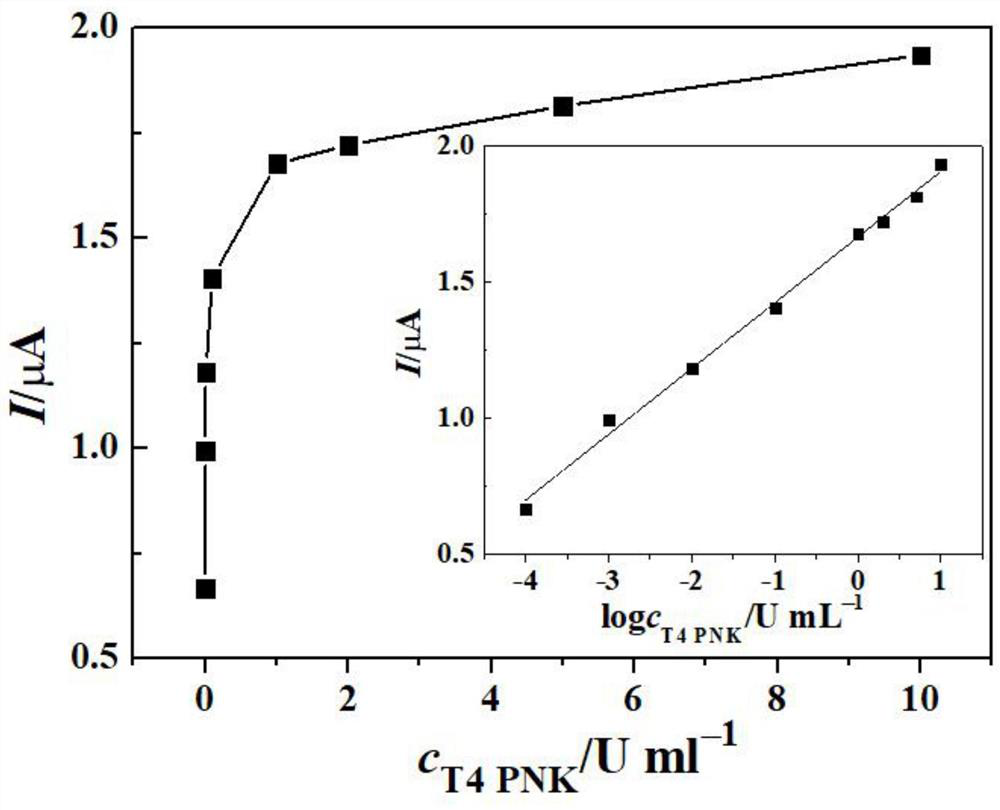Electrochemical analysis method for determining activity of T4 polynucleotide kinase based on magnetic nano material
A technology for polynucleotide and electrochemical analysis, applied in the field of electrochemical analysis based on magnetic nanomaterials to determine the activity of T4 polynucleotide kinase, to achieve the effect of improving selectivity, specificity and sensitivity
- Summary
- Abstract
- Description
- Claims
- Application Information
AI Technical Summary
Problems solved by technology
Method used
Image
Examples
Embodiment 1
[0040] An electrochemical method for measuring T4 polynucleotide kinase activity based on magnetic nanomaterials of the present invention
[0041] The present invention is based on Fe 3 o 4 @TiO 2 The principle of the method for detecting T4 PNK activity by magnetic core-shell nanoparticles and AuNPs dual signal amplification technology is as follows: figure 1 shown. First prepare the Fe 3 o 4 @TiO 2 Magnetic core-shell nanoparticles, in the presence of ATP and T4PNK, nucleic acid strand S 1 Phosphorylated at the 5′ end, the phosphorylated end of S1 is passed with TiO 2 Specific reaction, modified to Fe 3 o 4 @TiO 2 Magnetic nanoparticle surfaces. After adding AuNPs-S 2 nanoparticles, AuNPs are modified to Fe due to the hybridization reaction between nucleic acid strands S1 and S2 3 o 4 @TiO 2 On the surface of magnetic nanoparticles, the formation of Fe 3 o 4 @TiO 2 -S1 / S2-AuNPs complex. Finally, the magnetic gold electrode (GME) was used as the working ele...
Embodiment 2
[0043] Oligonucleotide sequence design
[0044] The oligonucleotide sequence designed in the present invention was synthesized by China Shanghai Sangon Bioengineering Co., Ltd., purified and tested by HPLC, and freeze-dried. The oligonucleotide sequence designed by the present invention is as follows: the nucleic acid strand S1 has the nucleotide sequence shown in SEQ ID No.1; the nucleic acid strand S2 has the nucleotide sequence shown in SEQ ID No.2 ;
[0045] Nucleic acid strand S1: 5'-SH-CACTTGGTTGGTGTGGTTGG-3';
[0046] Nucleic acid strand S2: 5′-ACACCAACCAAGTGATGAT-3′; dissolve the oligonucleotide in ultrapure sterilized water and store at -18°C for future use.
Embodiment 3
[0048] Fe 3 o 4 @TiO 2 Preparation of Magnetic Core-Shell Nanoparticles
[0049] Weigh 0.615g FeCl 3 ·6H 2 Dissolve O in 20 mL of ethylene glycol, add 1.8 g of NaAc and 0.5 g of polyethylene glycol, stir the solution, transfer it to a 100 mL Teflon-lined stainless steel autoclave, react at 200 °C for 8 hours, and cool to room temperature , washed several times with ethanol, separated by magnetic force, and air-dried at room temperature to obtain Fe 3 o 4 magnetic nanoparticles. Dissolve 9.6mL glacial acetic acid and 6.8mL butyl titanate in 60mL ethanol, add 0.4g Fe 3 o 4 Magnetic nanoparticles were ultrasonically dispersed for 15 min, 2.4 g of polyethylene glycol and 3.6 g of urea were added, stirred electrically for 1 h, and then the mixture was transferred to a reaction vessel for crystallization at 180° C. for 8 h. After cooling to room temperature, the precipitate was filtered and washed several times with ethanol, and dried at 80 °C for 12 h to give Fe 3 o 4 @T...
PUM
 Login to View More
Login to View More Abstract
Description
Claims
Application Information
 Login to View More
Login to View More - Generate Ideas
- Intellectual Property
- Life Sciences
- Materials
- Tech Scout
- Unparalleled Data Quality
- Higher Quality Content
- 60% Fewer Hallucinations
Browse by: Latest US Patents, China's latest patents, Technical Efficacy Thesaurus, Application Domain, Technology Topic, Popular Technical Reports.
© 2025 PatSnap. All rights reserved.Legal|Privacy policy|Modern Slavery Act Transparency Statement|Sitemap|About US| Contact US: help@patsnap.com


